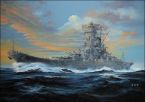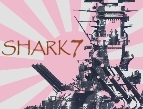Shark7
Posts: 7937
Joined: 7/24/2007
From: The Big Nowhere
Status: offline

|
quote:
ORIGINAL: el cid again
quote:
ORIGINAL: spence
I think what Ron is really objecting to is the relatively common multiengine torpedo bomber attacks in harbor (spit it out Ron - what you really mean are attacks by Bettys and Nells on shipping in harbor) which occur in the game of which the above cited is an example (though not involving Bettys or Nells). I hate them too but my biggest objection is not so much that they occur but that they score a percentage of hits that is ten or more times the rate at which they scored hits historically; that is, with the one and only one exception of the sinking of the PoW and Repulse. That attack was not against ships in harbor but in it the IJN flyers scored 20-30% hits with their torpedos. In common with a number of other RL events that singular performance appears to be taken as the standard by which the in-game weapons systems are judged. (Certainly one can not expect those same bombers to score fewer hits against ships tied up to a pier than they did against hi-speed warships manuevering at sea even though the ship's ability to manuever or not might well be the least of the problems faced by torpedo bombers attacking a harbor as the afore cited example indicates.) If the rate with which the Bettys and Nells score hits was brought in line with their historical average and if the availability of torpedos was a bit more in line with historical availability the problem would probably go away (aren't torpedos less available in AE?). But then the problem might be that PoW and Repulse can blithely sail into the South China Sea and wreak havoc on the IJN on turn 2 which would probably be a little too depressing for IJ Players.
The air units that attacked PoW and Repulse had evidently undergone intensive training in attacking ships with torpedos. From the tone of the interview with the former operations officer (I think) of one of those Daitai this training was not generic in any sense. Perhaps the specialization of aircraft/pilots for different mission profiles will correct the overall problem of Bettys/Nells undue capabilities if not all Betty/Nell Daitai are initially given the torpedo attack specialty.
(Certainly PH and Taranto and quite a few attacks by TF38/58 involved torpedo attacks in harbors by single engine torpedo bombers. Of note though is that the attacks on Port Darwin and the harbors in Ceylon by both Bettys and/or the torpedo bombers of the KB did not involve torpedo attacks.)
A technical observation here - which is not quite the same thing as saying there is nothing of value in Spence's point of view:
IF we take the attack on Force Z as a base
AND IF we compare it with an attack on ships in harbor
THEN we OUGHT TO SEE a MUCH HIGHER hit rate.
The chance of hitting a stationary target - or a slow target almost unable to maneuver as a ship in harbor is -
is far highter than it is of hitting a ship at full speed with complete freedom of maneuver as POW and Repulse had.
This observation leads me to be suspect of Spence's reasoning: he is reasoning from conclusions; he is not thinking about what SHOULD happen in a port.
For a better case of what should happen in port, look at PH or at Tarantao. Wether torpedo bombers have one or two engines machts nichts - they must fly low, strait, and not jink to have a good shot - and more or fewer engines changes nothing whatever about that. At PH it appears that it may be "every torpedo fired which did not bury itself in the mud struck a target." The principle uncertainty is "was one of the torpedoes fired NOT fired by an aircraft?" - and the answer to that uncertainty causes a slight variation in the hit rate. Note, however, that WITP so far does NOT provide for submarines to enter harbor - never mind that it really happened - nor does it provide for ships to have active or passive defenses (e.g. torpedo nets). It may be that some fraction of the torpedoes WOULD HAVE BEEN defeated had nets been rigged at PH. It also is not yet in the game that we can rate ports ease of entry in some way - so a place like Lahaina will seem less attractive because of its exposure to torpedo attacks. Lots of things might be changed/added - but the basic algorithms do not seem to be fundamentally wrong - just not properly modified for all situations.
In a mechanical game system requiring dozens of players to work out the math, played in public at Metro Seattle Gamers at Seattle University,
a wierd set of strategic circumstances caused a major naval engagement involving virtually every Allied cruiser in the Western Pacific and the Indian Ocean to engage a small task force of the IJN (so small that this game, which had many old players of great experience, that the task force was commanded by two high school boys - one in command - the other boss of two CVLs). This game involved a serious statistical number of torpedo attacks - of all types - ship, aircraft and submarine. The Japanese were pinned - unable even to try to run by the necessity of defending transport ships - and they had only two Battleships (Nagato and Mutsu) supported by appropriate numbers of cruisers and destroyers. I did a statistical analysis and found exactly 1 in 6 torpedoes found its mark - regardless of the fact we required REAL torpedo fire control solutions and tracked EACH torpedo - or that only a minority of players had ever done this before. If there is a "target rich environment" the number of hits can indeed be above 10% - although that won't happen for distant maneuvering targets in small numbers. I found that often a torpedo intended for one ship hit another ship. If we went to a really sophisticated analysis system, we would have to think about missed shots, particularly if there are many potential targets close abeam - as in harbor. As once happened in a famous Fletcher Pratt game in a New York gymnasium (a housewife beat a real navy captain of destroyers) our high school boys came off looking very good indeed - they made not a single operational mistake in the days and hours leading up to the tactical battle - and all we had to do was give their ships players to work out what happened. Designed to win a decisive naval battle at sea - it looks to me like the one place the Japanese torpedo was truly decisive was in port.
If I recall correctly, didn't the Japanese actually modify their Type 91 Torpedos so that they could use them at PH? I seem to remember something about them adding some type of fins to prevent them from diving as deep once released, cause that was the only way a torpedo was going to work in water as shallow as a port.
_____________________________
Distant Worlds Fan
'When in doubt...attack!'
|
 Printable Version
Printable Version




















 New Messages
New Messages No New Messages
No New Messages Hot Topic w/ New Messages
Hot Topic w/ New Messages Hot Topic w/o New Messages
Hot Topic w/o New Messages Locked w/ New Messages
Locked w/ New Messages Locked w/o New Messages
Locked w/o New Messages Post New Thread
Post New Thread